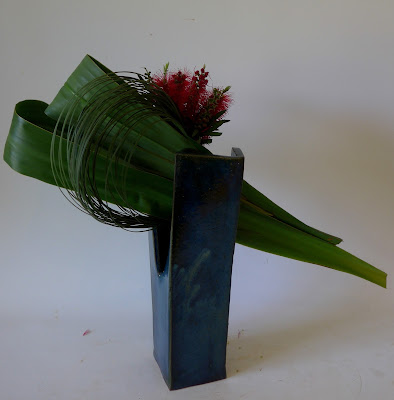I have two herbaceous peonies, that have been the source of great frustration for many years by their stubborn refusal to flower. I have tried everything, including freezing water into big blocks of ice and placing them on the ground above the plants to simulate frost. But to no avail. This year, to my great delight, each plant has produced four buds, thus earning a place in my blog. I'm guessing that the unusually cold winter may be the reason for them flowering but I can't be sure. I did not want to make an ikebana arrangement with them, firstly, because the stems are very short and, secondly, because the flowers make such a statement that they don't need anything else.
At the October meeting of Ikebana International Mr Barrie
Gallacher, a volunteer from the Australian Native Association spoke to us about
Australian natives and more particularly about the Royal Botanic Gardens in
Cranbourne. I had not visited those gardens before and was inspired to do so
after Mr Gallacher' talk. I highly recommend to anyone, who is able to visit
the gardens to do so. I learnt a great deal, most especially about how ignorant
I have been about Australian natives. One of the things I learnt is that the
plant I have been calling gyamea lily is actually doryanthes palmeri, also
knows as giant spear lily. It's the slightly different, doryanthes excelsa that
is known as Gyamea lily.
I had been asked to do a demonstration for the group
using Australian natives. I have to confess that I don't have many natives in
my garden (a situation I'm already rectifying). So the task was made more
challenging, firstly, in finding appropriate materials and, secondly, because I
prefer modern styles of ikebana and Australian natives tend to lend themselves
more to naturalistic work. But I felt I should rise to the challenge. I used
Doryanthes palmeri leaves, red calistemon flowers and bought some spear grass.
The resulting arrangement is below.
The theme for one of our recent lessons was 'In a suiban
without kenzan', for which I prepared the two examples below.
 |
| Hawthorn and calistemon |
 |
| Oak and rhododendron |
On the same day we also had students doing and
arrangement 'Emphasizing curved lines' and my example for that follows.
 |
| Wisteria and Cymbidium orchids |
Two weeks later, our theme was 'Seasonal Material', in
this case 'Spring' and I instructed the class to make it a 'maze-zashi'(a
mixture of a variety of materials and colours). Again my examples are below.
By coincidence, my teacher, Elizabeth had set the same theme for her class and I tried doing something a little different this time.
 |
| This wall arrangement of Strelitzia nocolai flower and leaf stands almost 2 metres in hieght |








No comments:
Post a Comment